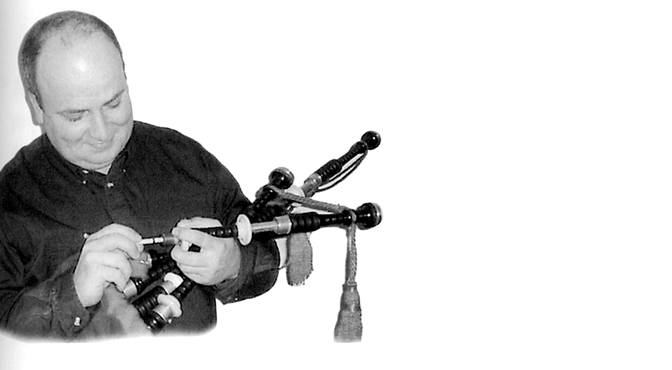This article, by reed expert and professional maker Chris Apps, first appeared in the Pipe Band Magazine 15 years ago but is as relevant today as it was then, especially as more bands are turning to cane to add depth to their overall sound…
 Are You Able to Handle Cane?
Are You Able to Handle Cane?
by CHRIS APPS
I LIKE the sound of cane drone reeds but don’t use them because plastic is so much easier to set and maintain. Are there any techniques for success with cane drone reeds? Yes, and it is important that all pipers, especially learners, learn these.
A lot of pipers become frustrated by cane because of a lack of basic understanding of the mechanics of a drone reed and ways of modifying them to make them produce the sound that is required. Cane does take more care and adjustment, but for a lot of pipers there is no substitute for the warm full sound produced from a well set up set of drones with cane reeds.
The first step to success with cane is in the selection of reed. It must be inspected for faults. Drone reeds are made from lengths of tube cane which are cut just past the node. The area within the node is pithy and porous and must be correctly sealed off with sealing wax. If the wax doesn’t completely cover the end it can be melted further by using a match or lighter. The tongue of the reed should be clean and free from any loose pieces of cane. Any stray pieces of cane or faults along the split of the tongue will impede the performance of the reed and may cause a leak. Any small slivers of cane can be carefully removed with a blade.
Once the reed has been visually inspected it can be tested for airtightness. The reed is placed in the mouth and blown. Whilst blowing pass a finger over the open end so that the tongue stops vibrating and closes. This must be an immediate stop with no sound of air leaking from the reed whatsoever. It is also important to ensure that the split on the tongue goes up to, or just beyond, the bridle. If it doesn’t pull the bridle back towards the open end of the reed and pull the tongue up so that the split reaches the bridle. The bridle can now be put back to its original position and the reed tested in the pipes.
When testing tenor reeds set the drone to the ideal length, that is with the top section of the drone about 1/8th of an inch, or 3mm, above the bottom of the sliding hemp joint on the tuning pin. When testing the bass, set the top section joint the same as the tenor and the bottom about two inches, or 50mm, up the pin from the projecting mount. Place the reed firmly in the reed seat making sure there is enough waxed hemp on it to make a firm seal. Now blow the reed in the drone. It should produce a rough gurgling sound that will change as the pressure increases to the warm rich sound you would expect to hear. This won’t always happen when you first try a reed. It will have undergone some changes since leaving the reedmaker’s bench, and may need to be adjusted. Here are a few examples of the problems that can be encountered with cane drone reeds and their remedies.
Reed too weak to play
Reeds often close up in transit. If the reed is too weak, pull the bridle back towards the open end of the reed. Use a match or a lighter to soften heavily waxed hemp to make it easier to move. Now gently pull the tongue of the reed up at about its mid section to increase the gap between the reed body and tongue. This is known as ‘springing’ the reed. The reed should be ‘sprung’ by a small amount at first increasing if the procedure has to be repeated. Now pull the bridle back to where it was and test the reed again. It should work correctly at this point but may not be the right pitch. This can be adjusted by a combination of moving the bridle (away from the reed seat to sharpen and towards to flatten), and the depth of the reed in the reed seat(further in to sharpen and further out to flatten).
Reed won’t vibrate but just clicks shut
This can be caused by the tip of the tongue catching on the body of the reed. Take a small round file and carefully file around the inside of the tip of the tongue without breaking through the top surface. If the top edge is compromised the reed will leak and have to be discarded. Once this has been done you may need to strengthen the reed as above No.1.
• To be continued
















Recent Comments